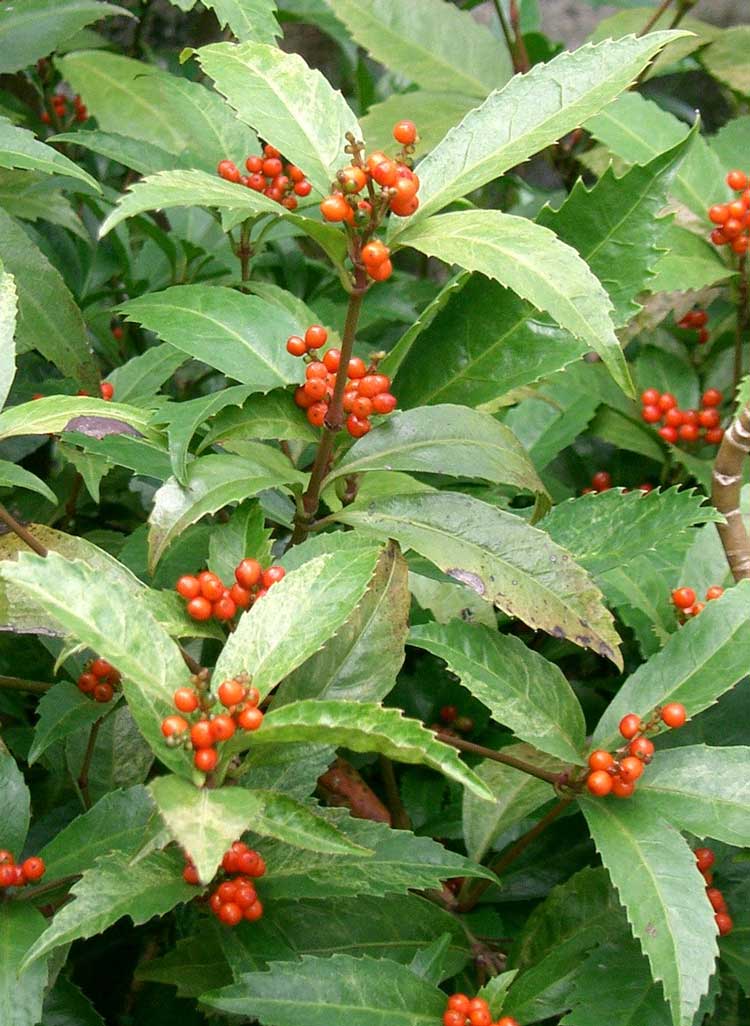
Sarcandra glabra (*)
Classification System: APG IV
Superregnum: Eukaryota
Regnum: Plantae
Cladus: Angiosperms
Ordo: Chloranthales
Familia: Chloranthaceae
Genus: Sarcandra
Species: Sarcandra glabra
Subspecies: S. g. subsp. brachystachys – S. g. subsp. glabra
Varietas: S. g. var. melanocarpa
Name
Sarcandra glabra (Thunb.) Nakai, Fl. Sylv. Kor. 18: 17 1930.
References
Nakai, T., 1930. Flora Sylvatica Koreana. Seoul 18:17, t. 2.
Links
Govaerts, R. et al. 2019. Sarcandra glabra in World Checklist of Selected Plant Families. The Board of Trustees of the Royal Botanic Gardens, Kew. Published online. Accessed: 2019 October 08. Reference page.
International Plant Names Index. 2019. Sarcandra glabra. Published online. Accessed: October 08 2019.
Tropicos.org 2019. Sarcandra glabra. Missouri Botanical Garden. Published online. Accessed: 08 October 2019.
USDA, ARS, Germplasm Resources Information Network. Sarcandra glabra in the Germplasm Resources Information Network (GRIN), U.S. Department of Agriculture Agricultural Research Service. Accessed: 07-Oct-06.
Vernacular names
日本語: センリョウ
中文: 草珊瑚
Sarcandra glabra is an herb native to Southeast Asia. It is also known as herba sarcandrae or glabrous sarcandra herb.
Aromatic oils may be extracted from the leaves. This extract may reduce immunologic attenuation due to stress, in mice. [2]
Morphology
Leaf blade elliptic or ovate-lanceolate, 6–17 × 2–6 cm, leathery, margin sharply coarsely-serrate. Stamen baculate to terete; thecae shorter than connective. Stigma subcapitate. Fruit globose or ovoid, 3–4 mm in diam.[3]
Distribution
Distributed in Vietnam, Sri Lanka, Taiwan, Cambodia, Malaysia, India, Japan, Korea, the Philippines and mainland China, Jiangxi, Anhui, Fujian, Guizhou, Guangxi, Hunan, Sichuan, Yunnan, Guangdong, Zhejiang and other places, growing at an altitude of 420 meters to 1,500 meters in area, often grown in wet slopes and valleys of the forest shade. It has not yet been cultivated by artificial introduction.
Common names
"Nine-knotted flower," "bone-knitted lotus."
in Japanese culture
The plant is called Senryō (千両) in Japanese. Because of the red berries and the word play of its name it is used during Japanese New Year for chabana decoration, normally along winter jasmine.[4][5] Another plant used instead because of its similarity is the coralberry tree and Ardisia japonica.[6]
References
The Plant List: A Working List of All Plant Species, retrieved 7 January 2017
He, RR; Yao, XS; Li, HY; Dai, Y; Duan, YH; Li, YF; Kurihara, H (2009). "The anti-stress effects of Sarcandra glabra extract on restraint-evoked immunocompromise". Biol. Pharm. Bull. 32 (2): 247–52. doi:10.1248/bpb.32.247. PMID 19182384.
Nianhe Xia and Joël Jérémie (1999), "Sarcandra Gardner, Calcutta J. Nat. Hist. 6: 348. 1845", Flora of China, vol. 4, pp. 132–138
"万両 千両 十両の見分け方 和風の自然な庭に似合う植物(12月)です - Hanana tree". 17 December 2017.
"千両/万両 せんりょう/まんりょう|暦生活".
"万両 千両 十両の見分け方 和風の自然な庭に似合う植物(12月)です - Hanana tree". 17 December 2017.
Retrieved from "http://en.wikipedia.org/"
All text is available under the terms of the GNU Free Documentation License

